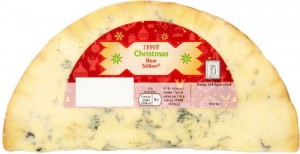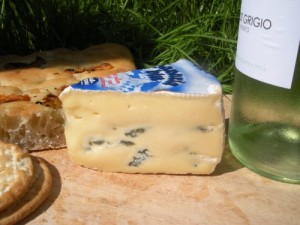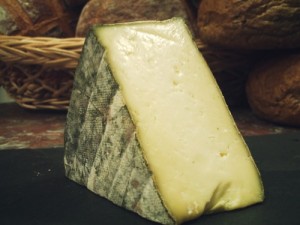Archive for December, 2013
Stilton
December 22nd, 2013 Posted 7:37 pm
With Christmas just around the corner, Stilton becomes an obvious choice for a post. In the weeks leading up to Christmas, many supermarkets are offering huge slabs of this famous festive favourite for very little money… but are they any good?
For reasons unknown, Stilton seems to have become associated with Christmas eating. Like dates, walnuts and Brussels sprouts, although available throughout the year, many people will only buy them over the Yuletide period. Is it because these things are considered so horrid that they can only be consumed once a year, under heavy intoxication?
In the past, I remember supermarket Stilton as this harsh, acidic, very strong wedge shaped lump that would attempt strip the lining of your mouth as you ate it. Indeed, I’m sure there are still shops that sell such gastric monstrosities together with spam and tinned boiled potatoes.
However, things have changed, and for the better. Whether the manufacturers or supermarkets have learned that this strategy does little for repeat sales and reputation, I don’t know, but the cheese has improved immensely and this can only be a good thing ![]()
It’s good, really very good, like Stilton should be. Strong in flavour, but not in attitude. Smooth and creamy both in texture and taste, with a robust, but not overpowering blueness. Just scrummy and for £4 for 550g (Tesco price), you can’t really go wrong.
Purchased from Tesco.
Reviewed by Nick & Olympia 2013.




 (4/5)
(4/5)
Posted in 4 Stars - Very Good, Blue, Cow's milk, English, Hard
Bavaria Blu
December 8th, 2013 Posted 8:47 pm
Sometimes sold under the name of Cambazola or Blue Brie, this pleasant little cheese that is easily available in many supermarkets. Though the alternative names suggest it could be Italian or French, it is actually German.
It is, by all accounts a blue Brie, using the same recipe as ordinary Brie. However, introducing the blue moulds is somewhat unconventional. Normally, the mould culture is added to the milk. During maturation, and starved of oxygen, it lies dormant until stainless steel wires are used to puncture the rind. With Bavaria Blu, the mould culture is introduced during maturation by injecting it directly into the cheese. This causes the blue moulds to be localised into little pockets rather than veins that pervade the paste.
Coated with a soft, dusty, edible, white rind. It has a cream to white paste, mottled with blue splodges, making it a quite attractive looking cheese.
Like a Brie, it has little or no smell, but unlike Brie it doesn’t produce a smell of ammonia when it gets really ripe.
It has a soft creamy texture, interspersed with the slightly harder patches of blue. A soft, delicate Brie like flavour with a gently blueness. As blue cheeses go, it is very inoffensive. A blue cheese for people that don’t like blue cheese.
Purchased from most leading supermarkets.
Produced by various manufacturers including: Cambazola, Bergader & Edelweiß
Reviewed by Nick & Olympia 2012




 (3/5)
(3/5)
Posted in 3 Stars - Good, Blue, Cow's milk, German, Semi-soft
Yarg
December 1st, 2013 Posted 6:27 pm
| It sounds like a pirate cursing a stubbed toe and comes from Cornwall, a place notorious for it’s pirates during the 16th century. The name, together with the fact that it is wrapped in nettle leaves, conjures thoughts of a four hundred year old traditional recipe… however, this is not the case.
Initially created in the 1980′s by Alan and Jenny Gray, Yarg is simply their surname spelled backwards. It sounds good though. The rind is covered with hand picked, blemish free, nettle (or wild garlic) leaves, meticulously laid so that no cheese is exposed. The result is a rather attractive dark, greyish green mosaic with a dusting of white mould that picks out the detailing and edges of the leaves. The pate is hard and crumbly, yellowing slightly towards the rind. The flavour is sharp, almost fresh, a bit like Wensleydale or Caerphilly, with light earthy and mushroomy overtones. The wild garlic version introduces a subtle garlicky flavour into the mix and is, in our opinion, the better of the two. Olympia is quite partial to this cheese, but I’m not so keen (but then I’m not a fan of Wensleydale or Caerphilly either). Having said that, if you are preparing a cheeseboard for guests, Yarg would make a good choice, adding both a visual and a flavour contrast. |
Produced by Lynher Dairies Cheese Company
Reviewed by Nick & Olympia 2010.




 (2.5/5)
(2.5/5)
Posted in 2 Stars - OK, Cow's milk, English, Flavour added, Hard



